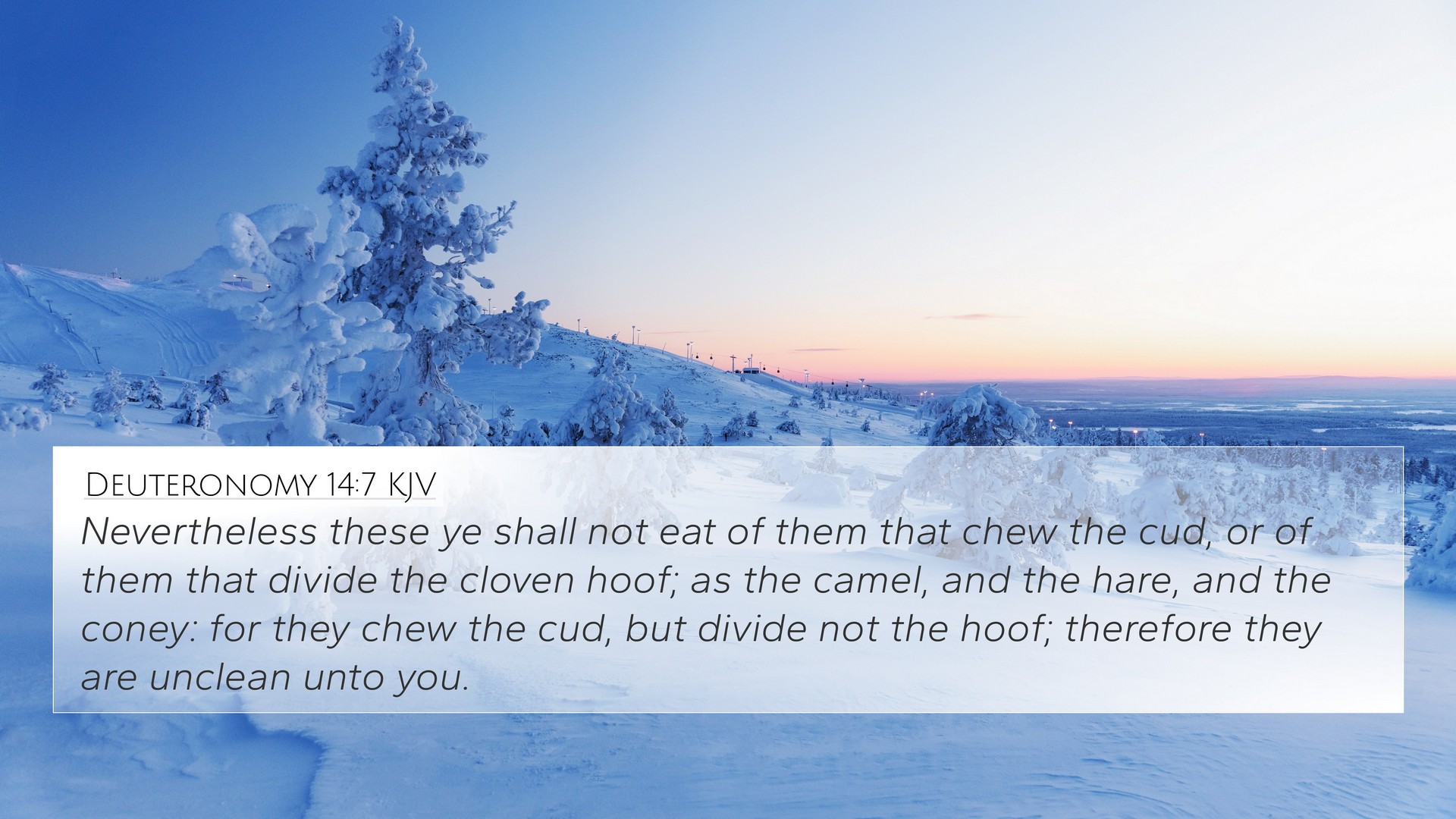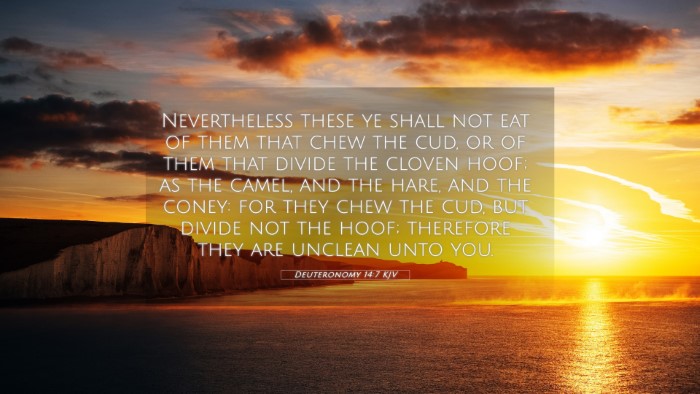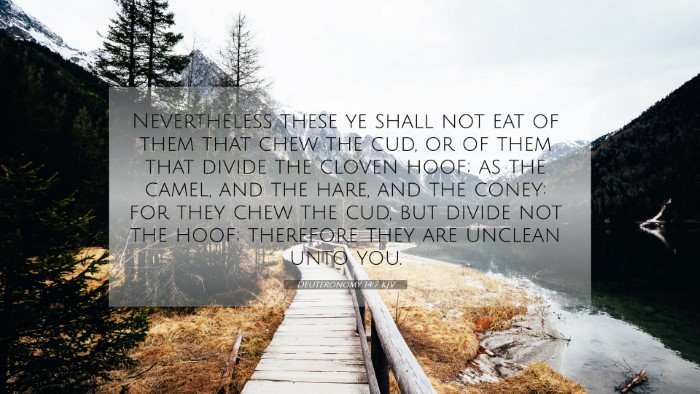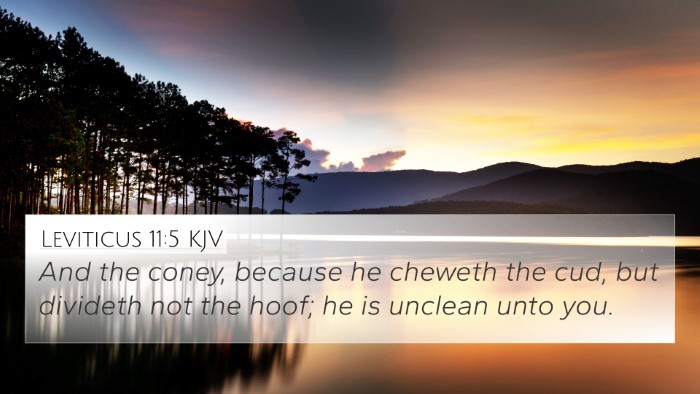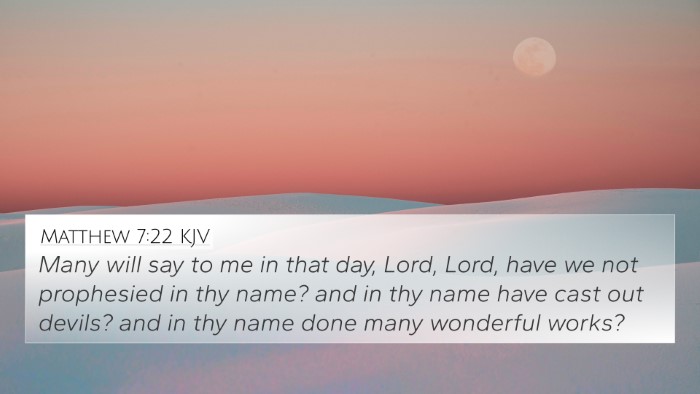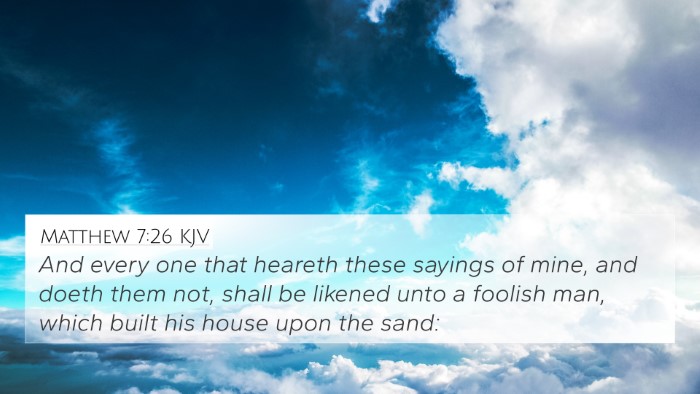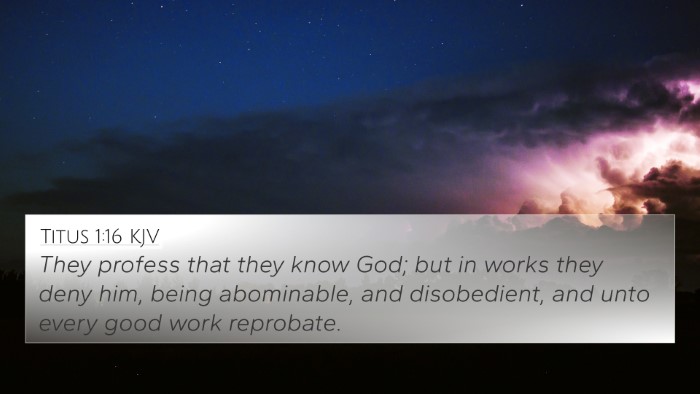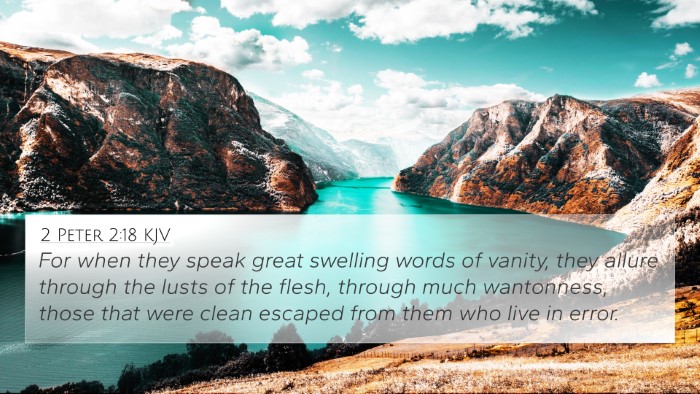Understanding Deuteronomy 14:7
Deuteronomy 14:7 states: “Nevertheless, these you shall not eat among those that chew the cud or that have cloven hooves: the camel, the hare, and the hyrax (or coney), for they chew the cud but do not have cloven hooves; they are unclean for you.” This scripture serves to establish dietary laws that reflect deeper spiritual truths about cleanness and uncleanliness in the context of God's covenant with Israel.
Summary of Insights from Commentaries
Matthew Henry's Commentary: Henry explains that the dietary laws serve a dual purpose—both for the health and spiritual welfare of the Israelites. The distinctions God makes in the clean and unclean animals symbolize the separation of Israel from the surrounding nations and their customs. Moreover, it is a call to holiness, instructing the Israelites to uphold God's standards in all aspects of life.
Albert Barnes' Notes: Barnes emphasizes that the laws regarding clean and unclean animals highlight God’s authority and the need for obedience. He elaborates on the idea that consuming certain animals can be seen as a metaphor for allowing unholy influences into one's life. This command is about maintaining purity and adhering to the prescribed order by God.
Adam Clarke’s Commentary: Clarke points out that the animals mentioned might appear to have characteristics that could align them with clean animals. However, these laws remind believers to look deeper than outward appearances. Clarke suggests that this verse contributes to the broader theme of recognizing that true cleanness comes from adherence to God's law, rather than mere outward behavior.
Thematic Analysis and Connections
The restrictions found in Deuteronomy 14:7 provide a foundation for understanding clean vs. unclean within scripture. This echoes across different scripture and strengthens the believer's discernment regarding spiritual purity. Below are some connecting themes and verses:
- Leviticus 11:4-8: Further elaborates on clean and unclean animals.
- Isaiah 66:17: Warns against unclean practices and their consequences.
- Mark 7:14-23: Yeshua teaches that what comes out of a person—such as sinful actions—is what defiles them, showing a reframing of purity.
- 1 Timothy 4:4-5: Highlights that everything created by God is good, but stresses the importance of thankfulness which reflects the heart's posture toward God.
- Romans 14:14: Paul discusses the principles of clean and unclean food in the context of community unity and personal conviction.
- Hebrews 13:9: Advises against strange teachings, connecting them to purity of doctrine and lifestyle.
- Acts 10:14-15: Peter receives a revelation concerning clean and unclean, showing how these distinctions evolve with the New Covenant.
Bible Cross-References for Deuteronomy 14:7
When studying Deuteronomy 14:7, one can find various Bible verses that echo its sentiment or theological implications. Here are cross-references worth considering:
- Leviticus 11:1-47: Lists all clean and unclean animals comprehensively.
- Matthew 5:17: Jesus emphasizes fulfilling the law, which includes understanding its depth and intent.
- 2 Corinthians 6:17: Calls believers to come out and be separate, resonating with the theme of purity.
- Colossians 2:16-17: Paul discusses dietary laws in light of Christ's fulfillment, underlining their temporary nature.
- 1 Peter 1:16: Calls for holiness among believers, aligning with Old Testament calls for cleanness.
- Psalm 119:105: Usage of God's word as a guide, reflecting the wisdom behind dietary laws.
- Revelation 21:27: Only those who are clean and written in the Lamb's Book of Life can enter the Holy City, emphasizing eternal purity.
Conclusion
Deuteronomy 14:7 offers rich insights into the nature of God's commandments, the importance of spiritual purity, and the overarching theme of faithfulness to God's covenant. By understanding these dietary restrictions as more than mere rules but as guidance toward holiness, we can appreciate the depth of God's wisdom in scripture. Utilizing tools for Bible cross-referencing can further illuminate these connections and provide a comprehensive perspective on how such laws reflect God's character and intentions for His people.
Further Exploration with Cross-Referencing Tools
Engaging in a cross-referencing Bible study can deepen one's understanding of the text. Resources such as a Bible concordance, or a cross-reference Bible study guide can aid in identifying links between various units of scripture. Here are some potential ways to delve deeper:
- Using a Bible cross-reference system to track themes and narrative progression.
- Employing cross-referencing Bible study methods, making note of recurring symbols and messages.
- Utilizing Bible reference resources to develop a thorough understanding of the context and theological implications.
- Participating in strategic studies that focus on cross-referencing themes in the Bible to discover connections between Old and New Testament themes.
Considering these aspects allows for a robust engagement with scripture, fostering both knowledge and spiritual growth.
